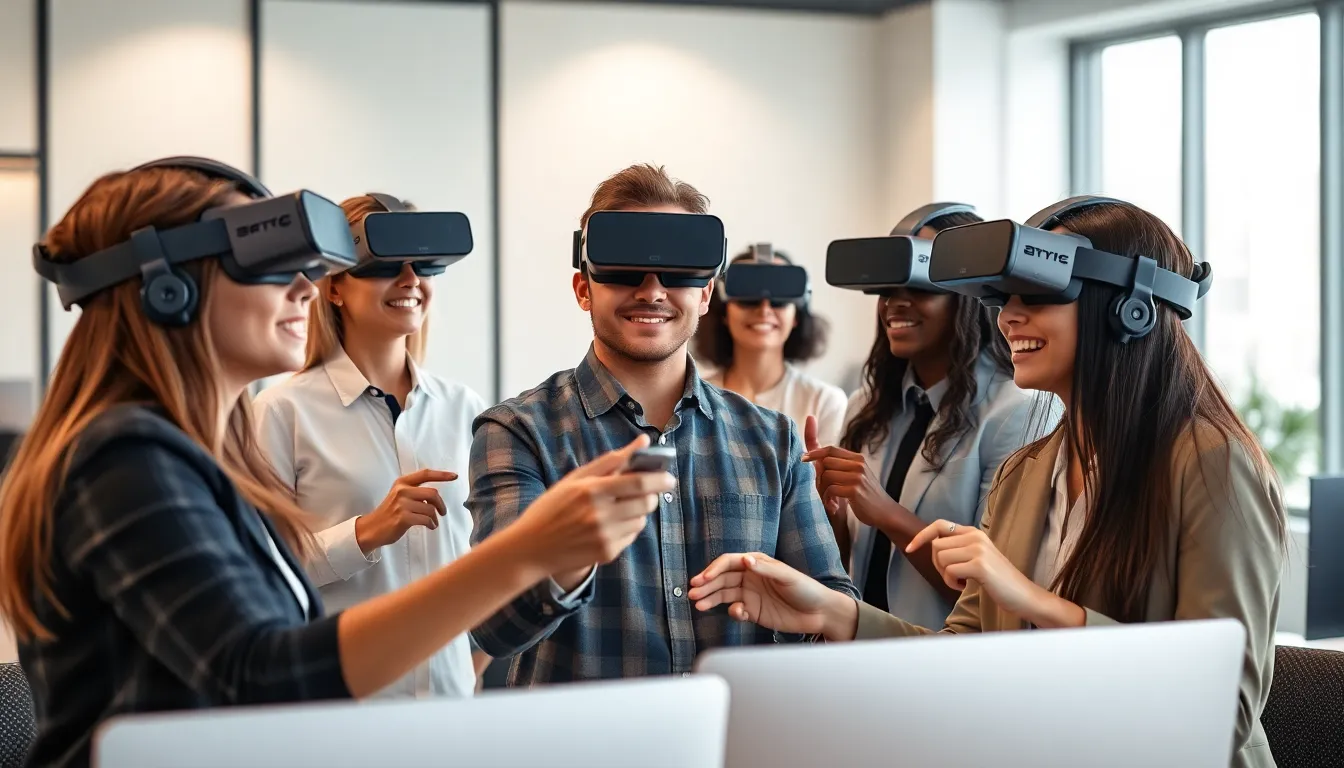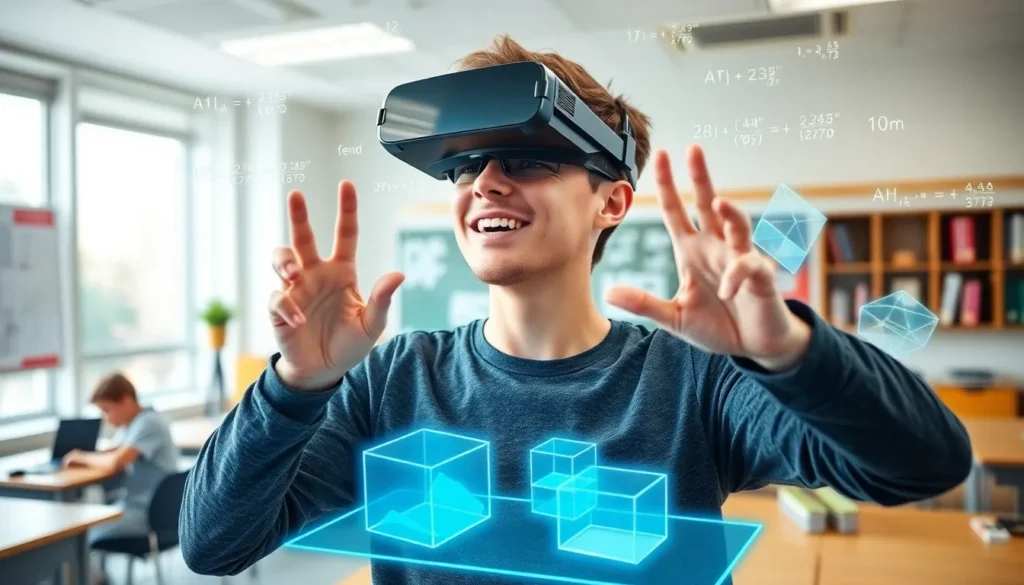Table of Contents
ToggleIn a world where reality sometimes feels like a boring rerun, AR headsets are the plot twist everyone’s been waiting for. Imagine slipping on a pair of sleek goggles and suddenly finding yourself in a vibrant, interactive universe where the mundane transforms into the extraordinary. Whether you’re battling virtual dragons in your living room or collaborating with colleagues across the globe, these gadgets are redefining how people experience the world around them.
But don’t let the sci-fi vibes fool you; AR headsets are not just for gamers and tech geeks. They’re revolutionizing industries from education to healthcare, making learning and training as engaging as a blockbuster movie. So, if you’re ready to elevate your reality and maybe even impress your friends at the next dinner party, it’s time to dive into the fascinating world of augmented reality.
Overview of AR Headsets
AR headsets integrate digital content with physical environments, creating immersive experiences. These devices utilize sophisticated technology, including cameras, sensors, and displays, to overlay information onto the user’s view. With a range of applications, AR headsets transform not just entertainment but also sectors like education and healthcare.
Education benefits from AR headsets by offering interactive, hands-on learning experiences. For example, students can visualize complex scientific concepts through 3D models. Healthcare professionals leverage AR technology during training and surgery, accessing critical data without diverting attention.
The design of AR headsets varies across brands and models, emphasizing comfort and usability. Some headsets feature adjustable components to fit different head sizes, while others focus on lightweight designs for prolonged use. Battery life also differs, impacting the duration of use in various contexts.
An increasing number of manufacturers are entering the AR headset market. Companies like Microsoft, Apple, and Magic Leap present notable examples, each with unique features catering to specific user needs. As competition grows, innovation accelerates, pushing the boundaries of what AR technology can achieve.
Consumer adoption of AR headsets continues to rise. Gamers appreciate the enhanced experiences, while professionals find utility in hands-free access to information. Market research indicates significant growth in AR technology, projecting a value of $198 billion by 2025.
Overall, AR headsets hold the promise of reshaping interaction with both digital and physical worlds. Their practical applications are expanding rapidly, making them pivotal in the evolution of how people engage with information and experiences.
Benefits of AR Headsets

AR headsets offer numerous advantages, enhancing user experiences and boosting productivity across various sectors.
Enhanced User Experience
Enhanced interactivity defines the user experience of AR headsets. Users engage with digital content and their physical surroundings simultaneously, creating a unique blend of reality and imagination. Immersive environments allow for deeper emotional connections with virtual elements. Gamers experience enhanced graphics and sensory feedback, increasing enjoyment during play. In education, students visualize complex ideas in three dimensions, leading to improved comprehension. Real-time feedback encourages exploration and experimentation, making learning more effective. Additionally, professionals benefit from interactive simulations, providing hands-on training without real-world consequences.
Improved Productivity
AR headsets significantly improve productivity for various industries. Professionals access critical information instantly without distractions, enabling them to focus on tasks at hand. For instance, workers in manufacturing utilize AR for real-time instructions, enhancing efficiency and reducing errors. Medical professionals streamline procedures by overlaying vital data during surgeries, improving accuracy. In design and architecture, AR enables teams to visualize projects in real-time, facilitating collaboration and faster decision-making. All these factors contribute to quicker problem-solving and innovation, making AR an essential tool in today’s fast-paced work environment.
Key Features to Consider
When selecting AR headsets, specific features significantly influence performance and user experience. Understanding these aspects helps in making informed choices.
Display Quality
Display quality plays a critical role in the overall effectiveness of AR headsets. High resolution enhances the clarity of digital content, ensuring a more immersive experience. Look for displays with at least 1080p resolution to achieve sharp images. Field of view also matters; a wider field allows for better immersion by showcasing more virtual elements within the user’s periphery. The refresh rate impacts how smoothly images appear, with 60 Hz being a standard minimum for seamless movement. Brands that focus on superior display technology provide users with richer visual experiences.
Comfort and Design
Comfort and design are paramount for prolonged use. Lightweight materials significantly reduce the strain on the user’s head and neck. Adjustable straps allow for personalized fits, enhancing stability during use. Ergonomic designs consider the shape of the user’s face, ensuring a snug but comfortable fit. Balanced weight distribution prevents fatigue during extended sessions. Users often favor headsets that incorporate padding around key pressure points, promoting better comfort. Aesthetic appeal also cannot be overlooked; a sleek design attracts a broader audience while increasing comfort levels.
Battery Life
Battery life directly affects usability, soaking up consideration during the selection process. A longer battery life allows users to engage in extended activities without interruptions. Many AR headsets offer 3 to 8 hours of usage; however, higher-end models often extend beyond that. Quick charging capabilities enhance convenience, reducing downtime when switching between tasks. Power-saving features can further prolong usage, automatically adjusting settings based on user activity. Understanding these battery dynamics ensures users maximize their headset experience without frequent recharges.
Popular AR Headsets on the Market
Several AR headsets are gaining traction, enhancing the scope of augmented reality in various sectors. Below are notable examples that showcase the capabilities of this technology.
Microsoft HoloLens
Microsoft HoloLens stands out with its advanced mixed reality features. The headset provides users with holographic displays that blend digital elements into real-world environments. Equipped with spatial mapping technology, it allows users to interact with 3D content seamlessly. In industries like healthcare and manufacturing, professionals leverage HoloLens for training simulations and real-time data access. Comfort and usability remain priorities, featuring adjustable components and a lightweight design that accommodates extended wear.
Magic Leap One
Magic Leap One offers an immersive experience, focusing on spatial computing. The headset’s lightweight design prioritizes comfort, granting users the freedom to explore their environments intuitively. This device incorporates advanced sensors and optical technology, enabling sophisticated interactions with both physical and digital objects. Developers leverage its capabilities for applications in gaming, education, and enterprise solutions, showcasing the headset’s versatility. Additionally, Magic Leap One emphasizes user-friendly design, allowing for easy customization and personalization.
Apple Vision Pro
Apple Vision Pro signals the company’s substantial entry into AR technology. It features high-resolution displays that deliver vivid colors and sharp details, enhancing user immersion. Designed for seamless integration with existing Apple ecosystems, it supports a range of applications in entertainment, education, and productivity. The headset’s ergonomic design ensures comfort during extended use, while its advanced tracking capabilities facilitate interaction with the surrounding environment. Apple Vision Pro represents a pivotal advancement in AR, appealing to both consumers and professionals.
AR headsets are redefining how individuals interact with their environments and access information. As technology advances and more companies join the fray the potential for these devices continues to expand. Their applications in education and healthcare demonstrate a clear shift toward more engaging and effective methods of learning and training.
With a growing market and increasing consumer interest AR headsets are set to become essential tools across various sectors. As users embrace these immersive experiences the future of augmented reality looks bright and full of possibilities. The evolution of AR technology promises to enhance everyday life making it an exciting time for both consumers and professionals alike.




